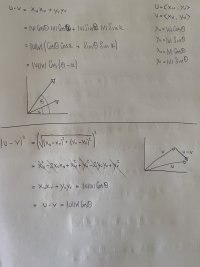Hello!
I was looking at the way to derive the formulae of the angle between to vectors from the law of cosine.
I want to get this, where the dot product of two vectors is equal to the product of the modulus of the two vectors and the cosine of the angle between them:
[math]uv = |u||v|Cos(A)[/math]
If I start with the law of cosine and simplify, I get this:
[math](u-v)^2 = u^2+v^2-2uvCos(A)[/math]
[math]u^2-2uv+v^2 = u^2+v^2-2uvCos(A)[/math]
[math]uv= uvCos(A)[/math]
At this point, I don't get why, on the expression before the equality, the product of the two vectors is a dot product, while on the expression after the equality is the product of the length of the vectors.
Thanks in advance!
I was looking at the way to derive the formulae of the angle between to vectors from the law of cosine.
I want to get this, where the dot product of two vectors is equal to the product of the modulus of the two vectors and the cosine of the angle between them:
[math]uv = |u||v|Cos(A)[/math]
If I start with the law of cosine and simplify, I get this:
[math](u-v)^2 = u^2+v^2-2uvCos(A)[/math]
[math]u^2-2uv+v^2 = u^2+v^2-2uvCos(A)[/math]
[math]uv= uvCos(A)[/math]
At this point, I don't get why, on the expression before the equality, the product of the two vectors is a dot product, while on the expression after the equality is the product of the length of the vectors.
Thanks in advance!

